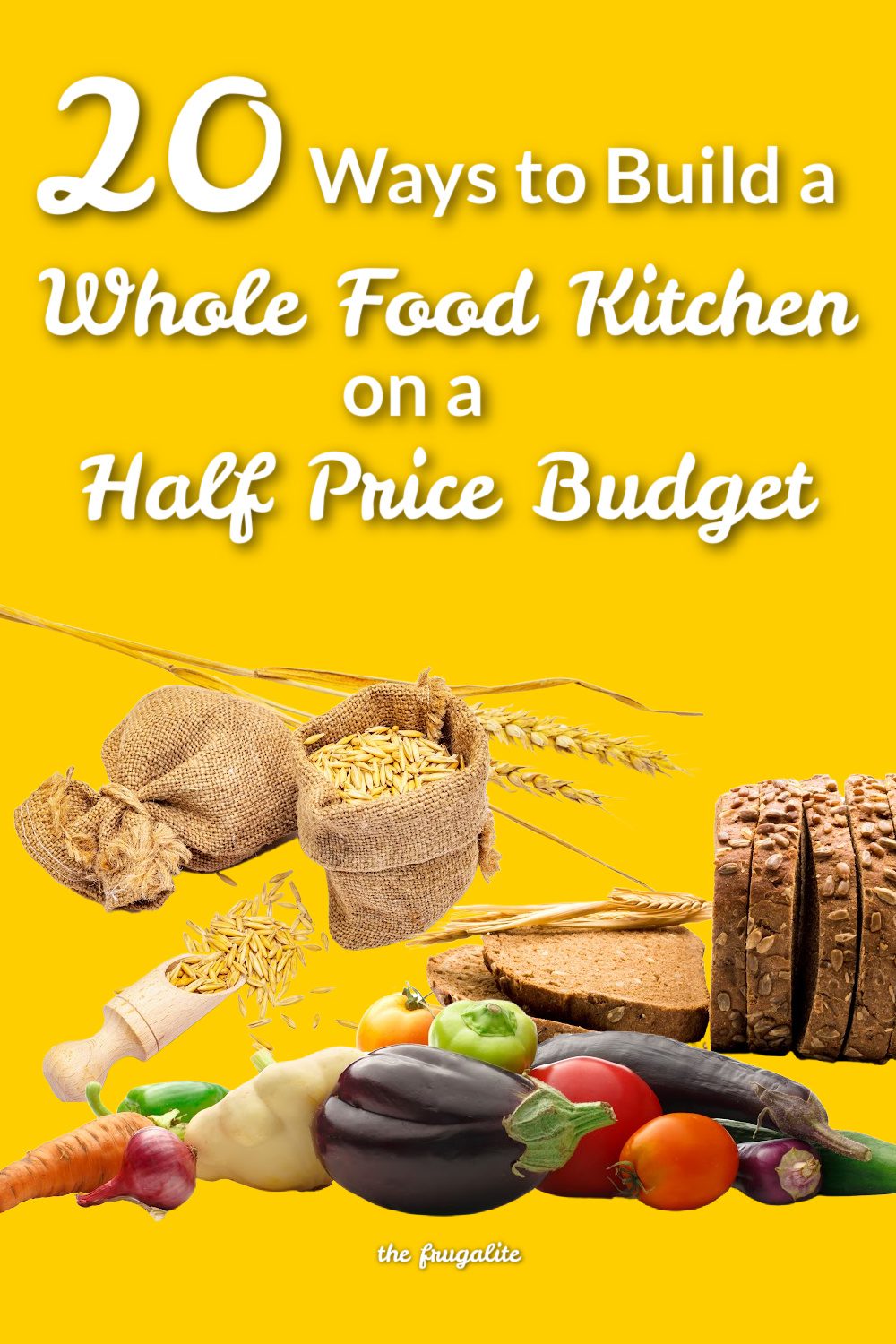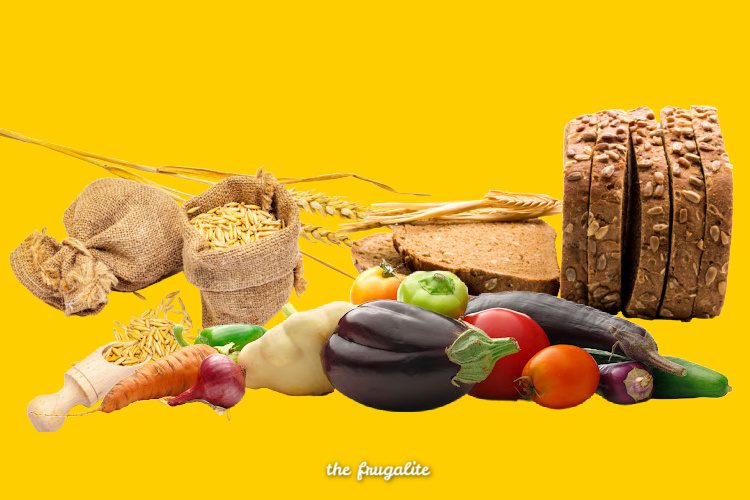(Psst: The FTC wants me to remind you that this website contains affiliate links. That means if you make a purchase from a link you click on, I might receive a small commission. This does not increase the price you’ll pay for that item nor does it decrease the awesomeness of the item. ~ Daisy)
We have all heard the importance of eating “whole food.” But, if you’ve ever walked into the grocery store that sports the name, you may have quickly deduced these were no ingredients for one on a frugal budget.
Yet making a trip to the “normal” grocery store these days is like running a gauntlet. From one side you are assaulted by food-like substances in brightly labeled packages, some even touting exaggerated health benefits from the toxins within. From the other side, you are gouged and poked by cleverly marketed “natural” foods that are 4 times the price of conventional foods. When you change directions to avoid one onslaught, you are immediately attacked by the other.
We’re at war and the grocery store is the battlefield
That war has been declared on us by multiple enemies with unlimited budgets, such as Monsanto, Big Pharma, Big Agri and Big Food. What’s even worse is that they are aided and abetted by their allies at the FDA and the US Congress, administrations peopled by those who are actually supposed to be the gatekeepers that protect us from this.
What’s a frugal whole food shopper to do?
Lots of people write to me and say, “I’d love to eat the way you do, but I can barely afford regular groceries. There’s no way I could afford all that healthy, whole food stuff.”
Whole food might be expensive, but have you seen the price of illness?
If you don’t believe you can afford to eat healthfully, consider the high price of being sick and lethargic. Calculate the cost of days missed from work for illness. Add up the price of having no energy to play with your kids or to do things that would help you to save money. Think about the exorbitant prices of medical care. Many of these things are completely avoidable – all you have to do is feed your body whole food and you will be astounded at the resultant glowing health. How much money have you spent over the last year fighting ill health that could have been avoided through good nutrition?
GMOs have been proven to cause cancer, ghastly tumors, organ failure, and death. Many of the additives included in the products proudly displayed on grocery store shelves have been banned in other countries because of the health consequences they wreak. Top this with a produce section absolutely drenched in pesticides that have been proven to result in cancer, hormone disruptions, and learning problems in children.
To quote the Terminator, “Come with me if you want to live.”
Realistic tips to help you switch to a whole food diet
We all know the reasons that we should switch to eating a whole food diet, but with the ever-increasing checkout counter inflation, how can we make it happen? Here are a few realistic tips that do NOT include relocating to 30 acres of prime, spring-fed, organic farmland blocked off on three sides by mountain ranges. Realistically, you may not be able to make every one of these things happen, but for each positive change you make, you are taking steps towards better health and you are revolting against the toxic food cartel.
- Buy local. Ideally, you never need to set foot in a grocery store. Change your shopping habits and buy from local farmers, either directly from their farm or from a farmer’s market. You will get your produce at the optimum time, right after it was picked. As well, you can directly ask the farmer about his practices. Sometimes farmers grow organically and they just haven’t gone through the expensive and highly regulated certification programs that exist to increase the monopoly of factory farms. (Find a local farm HERE.)
- Join a food co-op or CSA. This is win-win because it helps out the farmers and it helps out your family. With both of these options, you can register ahead of time (in some cases you pre-pay for the season) and then receive a box brimming with abundance from your own area. You will get to try lots of new things (this is how we tried one of our family favorites, rutabaga, for the first time) and you will get to do this at a fraction of the price.
- Buy produce that is in season. Purchasing food that is in-season is not just cheaper, it is nutritionally beneficial too. Buying strawberries in January and asparagus in October requires that the produce be picked before it is fully ripe, and the produce begins to decompose and lose nutrients the second it is separated from the plant. Avoid the high cost of transporting your “fresh” Christmas berries and melons and stick to the items that nature is currently providing in your area.
- Grow as much as you can in the space you have. Plant a sunny windowsill with salad veggies and herbs, grow a container garden on a balcony or turn your yard into a mini-farm. Every bite of food you grow yourself is a revolutionary act.
- Plan your menu AFTER shopping, not before. This allows you to stay on budget because you aren’t shopping for special ingredients to make pre-planned meals. You can take advantage of the best deals and plan your meals around those. This can also help by keeping those unplanned budget purchases from going to waste in your crisper drawer while you carry on with your planned menu.
- Drink water. We generally stick to drinking water. Not fluoridated tap water – we purchase 5-gallon jugs or fill them in a spring when that option is available. Water is cheaper and healthier. Beverages that you make yourself like coffee and tea are far less expensive than the soda pop and energy drinks that fill most modern refrigerators, not to mention, relatively free of the toxic chemicals that overflow in the store-bought drinks.
- Buy staples in bulk. Organic grains like brown rice, wheat berries, cornmeal, barley, and oatmeal can be purchased in bulk quantities. This reduces the price to lower than or equivalent to the smaller conventional packages that are offered in your local grocery store. You can buy a WHOLE lot of WHOLE food this way. (See what I did there?)
- Buy some meats frozen instead of fresh. Some butcher shops freeze meat that isn’t sold immediately and sell it for a lower price. Look for deals on frozen chicken breasts, frozen fish, and frozen turkey breast. Fish is nearly ALWAYS cheaper frozen. Just read your ingredients carefully and make sure you are just getting fish, and that the fish is from a safe source (not the radiation-laden Pacific Ocean, for example, or a tilapia farm where they feed fish their own recycled feces).
- Buy meat in bulk. Look into buying beef in quantity. Check out the prices at local farms for a quarter of a cow. You will pay slightly more for the lesser cuts but much less for the better quality cuts. It balances out to a much lower price for meat farmed in the healthiest way possible.
- Add some lower-priced protein options. While lots of us would love to have grass-fed beef and free-range chicken breasts twice a day, the cost is prohibitive. Add value-priced wholesome protein with beans, farm-fresh eggs, homemade yogurt and cheese, nuts, and milk.
- Stop eating out. Just one McCrud meal for a family of 4 is between $20-30. Delivered pizza is about $25 plus a tip. The $45-55 that you would spend for this “convenience” could buy a LOT of whole food.
- Get into the habit of bringing a cooler with you. If you are going to be out running errands for the day, load up a cooler with healthy snacks, water, and even a picnic lunch. This is the perfect answer to the lament from the back seat, “I’m huuuunnnngryyyy.”
- Don’t buy anything with an ingredients list greater than 5 items. The more items on the ingredients list, the more likely you are to be consuming someone’s chemistry project. Even things that sound relatively innocuous, like “natural flavorings” can be, at best, unappetizing, and at worst, harmful.
- Cook from scratch. Cooking from scratch doesn’t have to be as time-consuming as you might expect. I don’t spend hours each day slaving in the kitchen. Spend a weekend afternoon prepping your food for the week ahead and you can have weekday dinners on the table in less than half an hour. Consider the price differences in homemade goods: homemade tortillas (pennies for a package that would be $3 at the store), pizza dough, peanut butter oatmeal cookies, trail mix, and granola bars. This stuff is literally pennies on the dollar in comparison to the same goods store-bought.
- Some conventionally grown foods are okay. Learn about the Dirty Dozen and the Clean Fifteen. Some foods have a fairly low pesticide load, even when conventionally grown. Use these foods to help offset the higher prices of items that are soaked in poison, like strawberries.
- You will actually eat LESS when you feed your body. Part of the reason that the obesity problem is epidemic in North America is because people are desperately seeking nutrients from depleted food-like substances. Their bodies are crying out, “I’m hungry!” even though they have consumed thousands of calories because their nutritional requirements are not being met. What’s more, many chemicals are added because they are engineered in a way that makes you want to eat more and more (like MSG, for example). They don’t stimulate the satiety centers in the brain that tell your body that it’s full.
- Brown bag your lunches. When I worked outside the home, most of my coworkers ate out every single day. They often invited me along, saying that a certain restaurant offered “healthy” food. The thing is, the price of that presumably healthy food was 4-6 times higher than the healthy food that I had brought from home. My daughter takes a healthy lunch from home to school every day, as opposed to eating the offerings there. Depending on the school, this may or may not be cheaper, but it’s guaranteed to be more nutritious. Here’s an article about brown-bagging it.
- Preserve food. Whether you grow it yourself, rescue it from the “last day of sale” rack at the grocery store, or buy it by the bushel from a farmer, learning to preserve your own food allows you to buy in bulk and squirrel some of that delicious food away for the winter ahead. Canning, dehydrating, and freezing are all methods to help extend the summer harvest for use later in the year.
- Eat leftovers. The act of eating leftovers is almost unheard of, it seems. But if you put aside small amounts of leftovers in a freezer container, you can make “soup” for a meal that is basically free because it came from items that would have otherwise been discarded. Use larger amounts of leftovers for lunch boxes or a “buffet-style” meal for the family. Get more leftover ideas here.
- “Shop” from nature. You might be surprised to learn how many edible plants are growing wild in your own neighborhood. Even city dwellers can often find things to forage. When we lived in the city, we used to pick up fallen walnuts from a tree in a local park. For those not ethically opposed to it, hunting or fishing can abundantly supply your protein needs, and you don’t have to worry about whether or not you are consuming antibiotics and hormones with game.
Are you ready to make the switch to a whole food diet?
If you’re ready to make a change to a whole food lifestyle, don’t let your budget hold you back! Take a long hard look at what you are spending on take-out coffees and lattes, fast food, delivered pizza, microwave meals, and frozen dinners that you shove into the oven. Look at the beverage budget you spend at the grocery store every week and keep track of how many soda pops you buy from the vending machine at work. You might be pleasantly surprised when your budget goes down, instead of up!
Do you have any tips for replacing processed foods with whole foods? Have you done so? And did you spend more money or less in the long run? Share your thoughts in the comments.












11 thoughts on “20 Ways to Build a Whole Food Kitchen on a Half Price Budget”
Great article. We usually hear the “I’m hungry.” before we get on the main road. Lol
Great article. Wish I read it before I ate fast food for lunch today. I felt great before lunch. Now, well, not at all . I’m very tired and feel ill. Of course, I know better. So, I’m going to do the cooler idea. Then when my son is hungry I will have something for him and me as well.
An addendum to #13.
If you can’t pronounce an ingredient, put it back.
The cheap comes out expensive, in food as well as life in general. The reason cheap foods are so cheap is there’s no actual food in them. A body starved for nutrients gets very, very sick-diabetes, hypertension, and obesity to name a few. A nutritious, whole food diet is far, far cheaper and better! Where there’s a will, there’s a way.
Daisy, can you list some of the places you shop at to get your whole foods, please? Grains and such? So you ever use dehydrated veggies in your day to day food prep? Thanks.
You just answered this question in another post thru a link, thanks. I just have to look them up online and do the math and compare the online stuff to grocery store prices.
I get organic stuff from Misfits Market – sometimes the prices are better than my grocery store, or at least as good, only everything is organic. So it might be an option for some. It’s a nice supplement as I go more and more organic and they also have pantry goods.
I also use Misfit Markets. I’m very pleased. Here’s a link for anyone interested: https://www.misfitsmarket.com/?promo=COOKWME-PM2EHZIBJYK
I grow a lot of what I eat. I can in glass or sun dry a good percentage of that to feed me the rest of the year. What I spend is a small percentage of my food. So if I spend for quality its affordable.
Eating grains like oats or grits instead of boxed cereals will save a lot of money that will offset other purchases. Some areas have salvage grocery. I am able to buy organic canned goods and fresh produce for a fraction of the price, bit it’s hit and miss I buy then decide what to cook. There frozen section often gets some organic grass fed beef and lamb for under 3.00 a pound. Organic greens and fresh herbs cost ortune so my garden space is spent growing salad stuff for the best return on the space.
Look into Azure Standard. See if they have a monthly drop point near you. High quality, lots of organic choices-this is where I get my bulk oatmeal, rice, flour.